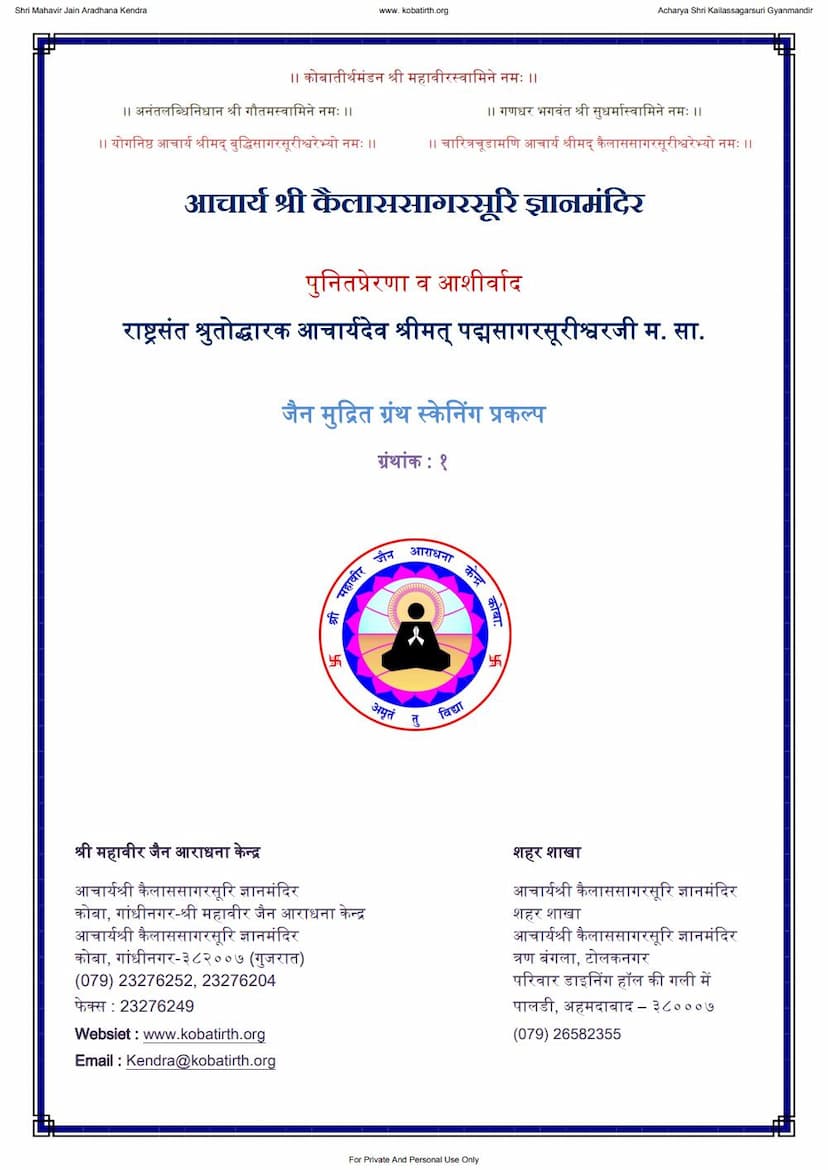Taittiriya Samhita Part 03
Added to library: September 2, 2025

Summary
This document is a scanned copy of Volume III of the Taittiriya Samhita (Krishna Yajur-Veda), accompanied by the commentary of Bhatt Bhaskar Misra. Published in 1895 by the Government of Mysore, it was edited by A. Mahadeva Shastri and K. Rangacharya.
The text begins with a preface mentioning the use of an additional Grantha manuscript for the commentary on the second Kanda. The table of contents (विषयानुक्रमणिका) then outlines the structure of Volume III, covering parts of the first Kanda (Prasnas 7-8) and the entire second Kanda (Prasnas 1-2).
The bulk of the content consists of the Sanskrit text of the Taittiriya Samhita and Bhatt Bhaskar Misra's commentary. The commentary provides detailed explanations of Vedic mantras, rituals, and their underlying philosophical significance, drawing extensively from earlier grammatical and exegetical traditions.
Key sections covered include:
- First Kanda, Prasna 7 (First Part): Focuses on various rituals and mantras related to 'Ishtis' (sacrificial offerings), including the ritual of 'Ida' (a specific sacrificial offering), 'Anuyaja' (secondary offerings), and mantras for appeasement and invocation. It also delves into mantras associated with the 'Vajapeya' sacrifice, such as those related to chariots, poles ('Yupa'), and consecration ceremonies.
- First Kanda, Prasna 8 (Second Part): Details rituals and mantras for the 'Rajasuya' sacrifice, including various offerings like 'Anumata' and 'Nairrita', and the eight 'Vaishvadeva' offerings. It further elaborates on the 'Samsapya' and 'Dashapeya' rituals, and offerings made during the 'Varuna Praghasa' and 'Sakamadhvas' ceremonies. Important sections cover 'Mahapitryajna' (Great Ancestral Sacrifice), 'Tryambaka' sacrifice, and 'Shunaseeriya' and 'IndraTuriyya' sacrifices, along with associated rituals and donations. Mantras related to bathing, dressing, and military expeditions are also included.
- Second Kanda, Prasna 1 (First Part): Focuses on 'Kamya' (optional or wish-fulfilling) animal sacrifices, enumerating a wide range of animals prescribed for specific desires such as progeny, wealth, fame, and spiritual knowledge. Each desire is linked to a particular deity and the corresponding animal offering.
- Second Kanda, Prasna 1 (Second Part): Continues with 'Kamya Ishtis' (optional sacrifices), detailing various offerings for specific aims like progeny, victory in battles, obtaining spiritual brilliance, and fulfilling desires for wealth and sustenance. It also covers offerings for atonement of sins and specific circumstances like being afflicted by evil or facing enemies.
- Second Kanda, Prasna 2 (Third Part): Primarily deals with the 'Chaturmasya' sacrifices, a set of three annual sacrifices (Varuna Praghasa, Sakamadhvas, and Sunaseeriya). It meticulously lists the specific offerings (homa) and mantras for each day of these sacrifices, emphasizing the deities invoked and the desired benefits.
- Second Kanda, Prasna 2 (Fourth Part): Continues the 'Chaturmasya' rituals, detailing offerings for the third day (Sunaseeriya) and concluding with the 'Mahapitryajna' (Great Ancestral Sacrifice). It outlines specific offerings and mantras for appeasing ancestors and invoking blessings for the lineage. The section then moves to the 'Shunaseeriya' sacrifice and its associated rituals.
- Second Kanda, Prasna 2 (Fifth Part onwards): The remaining sections of the second Kanda cover the 'Shunaseeriya Havis' (offerings), 'Indra-Turiyya Havis', and 'Panchadhmia Homa', along with their respective donations. It then moves to the 'Abhishechaniya' (consecration) and 'Dikshaniya' (initiation) rituals, including mantras for acquiring water, bathing, and victory in conquest. Offerings for specific occasions like 'Avashthya' and 'Prayuja' are also mentioned, followed by mantras for the 'Sautramani' sacrifice, which involves libations of Soma juice. The text concludes with rituals and mantras for 'Rathina' sacrifices and the 'Abhisechaniya' and 'Dikshaniya' rites.
The commentary by Bhatt Bhaskar Misra is extensive, providing grammatical analysis, etymological explanations, and interpretations of the symbolic meanings of the rituals and mantras, often referencing earlier authoritative texts and traditions. The text is written in Devanagari script, and the English summary provided here is based on the understanding of the Sanskrit content. The presence of the Shri Mahavir Jain Aradhana Kendra and its associated names on the initial pages indicates this particular edition was preserved or digitized by this Jain institution.